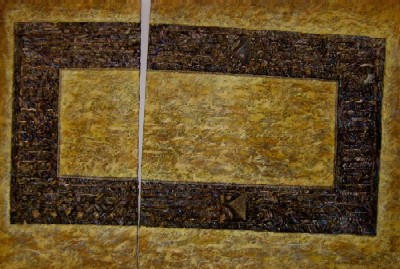![]()

Cornice spezzata in giallo, olio su tela 200X300, anno 2008
![]() Luigi Granetto (Rovereto, Italy - 1950) generated intense motion
in the fields of literature, poetry and essays. The aim of inventing efficient editorial
formulas has contributed to research in various interdisciplinary aspects of
the arts and also deals with music and theater. An uneasy and fairy painter,
Granetto arranged many private exhibitions in the most renowned art galleries in
Italy and the rest of the world. In 1987 he displayed seven large canvases on
the creation of the world to celebrate Franco Battiato’s "Genesi"
at the Theatre Regio in Parme. In 1995 he displayed his projects for the
Consorzio Replastic at the Palazzo
della Triennale.in Milan. in 1999, a collection of 100 works on the world of
fashion were put on
display and then reexhibited in 2000 in Milan, at the Galleria Vittorio Emanuele
and at the Spazio Oxus.
In June 2005, he displayed his work with Pesce and Lodola at the Estense Castle
Museum in Ferrara on the occasion of the interdisciplinary exhibition
“Dreamers of Colors/Art and Fashion” Other private exhibitions are :in Milan
Visionnaire Design Gallerry
2010, Galleria San
Lorenzo 2009, Miart
2008, Miart 2007,
in Stuttgart: Fellbach
Haustelle
Luigi Granetto (Rovereto, Italy - 1950) generated intense motion
in the fields of literature, poetry and essays. The aim of inventing efficient editorial
formulas has contributed to research in various interdisciplinary aspects of
the arts and also deals with music and theater. An uneasy and fairy painter,
Granetto arranged many private exhibitions in the most renowned art galleries in
Italy and the rest of the world. In 1987 he displayed seven large canvases on
the creation of the world to celebrate Franco Battiato’s "Genesi"
at the Theatre Regio in Parme. In 1995 he displayed his projects for the
Consorzio Replastic at the Palazzo
della Triennale.in Milan. in 1999, a collection of 100 works on the world of
fashion were put on
display and then reexhibited in 2000 in Milan, at the Galleria Vittorio Emanuele
and at the Spazio Oxus.
In June 2005, he displayed his work with Pesce and Lodola at the Estense Castle
Museum in Ferrara on the occasion of the interdisciplinary exhibition
“Dreamers of Colors/Art and Fashion” Other private exhibitions are :in Milan
Visionnaire Design Gallerry
2010, Galleria San
Lorenzo 2009, Miart
2008, Miart 2007,
in Stuttgart: Fellbach
Haustelle
![]() Granetto links himself whith that particular lateral
expressiveness, which has consolidated itself in the material
tonalism of the great Venetian painting. It has provided a latent
language to all the Spanish painting, from Greco to the early
Picasso, from the Flemmings, French impressionists, German
expressonists, to the complex experience of Turner and Bacon. It
is the kind painting which abolishes any theological or
idealistic absolute from the relationship, between matter and
thought, whether this is derived from the Roman humanist
tradition, from Pompei to Pontormo, retaken in our age by all
that painting strongly motivated by a need to programme, like De
Chirico's metaphisics, Ernst's surrealism, the sociology of
Sironi or Leger, up to the recent phenomena of American
hyper-realism or italian anachronism; or derived from the
experience of a Cartesian mechanistic mentality, faithful to the
utopic idea of progress like in futuristic experiences,
Mondrian's phobic equilibrium, Duchamp's nihilist conceptualism,
etc.
Granetto links himself whith that particular lateral
expressiveness, which has consolidated itself in the material
tonalism of the great Venetian painting. It has provided a latent
language to all the Spanish painting, from Greco to the early
Picasso, from the Flemmings, French impressionists, German
expressonists, to the complex experience of Turner and Bacon. It
is the kind painting which abolishes any theological or
idealistic absolute from the relationship, between matter and
thought, whether this is derived from the Roman humanist
tradition, from Pompei to Pontormo, retaken in our age by all
that painting strongly motivated by a need to programme, like De
Chirico's metaphisics, Ernst's surrealism, the sociology of
Sironi or Leger, up to the recent phenomena of American
hyper-realism or italian anachronism; or derived from the
experience of a Cartesian mechanistic mentality, faithful to the
utopic idea of progress like in futuristic experiences,
Mondrian's phobic equilibrium, Duchamp's nihilist conceptualism,
etc.
This type of Painting in principle eludes any centralization, to
establish between itself and the world, an extremely mobile
system or swings, able to renew itself within the continous
stratification of experiences and solicitations, internal and
external to it.
The signs which are recognizable in this kind of painnting are, a
picture which is always trying to escape from itself, a
discontinuous and vibrant colour, never peremptorius, a
lightdfisingaged from the rigid relationship it has with its
shadows.
A materiality which conditions the subjectivity of its
manipulator. A symbolic system constructed like one of Bach's
suite, where the variations of the formal scheme that contains
them are more important.
An idealistic tendency always prepared to receive a ciarification
of the doubt, to discern the reverse of the medal, to reveal
itself. A breadth which is not reduceable to a particular
historical age or any chronicle needs.
A suffered and acrobatic resonance with mutations of civilization
and finally a profound irritation with rhetoric.![]()
| Archeologia | Publishing | Genesis | Il Trono Vuoto | Les Lunettes de Mondrian |
| Gnomiz | Tele Giuliane | Press | Biography |.
a Home Page
Arte
Gnomiz*
a a